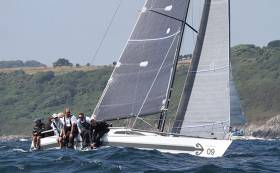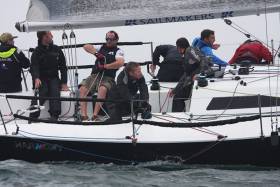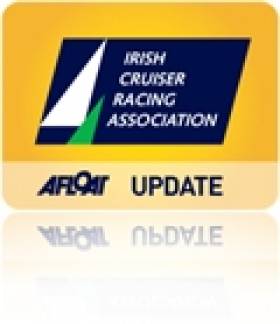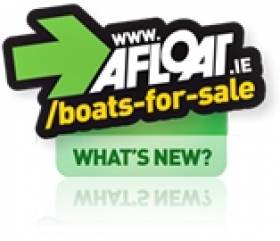Displaying items by tag: Half tonner
Half Tonners Heading For Kinsale 2017 As Swuzzelbubble Lifts Classics Cup in Falmouth
Sadly strong winds and huge seas meant that racing had to be cancelled on the final day of the Henri Lloyd Half Ton Classics Cup in Falmouth. Race Officer Jack Penty met with the skippers at 08.30 to review the situation, but it was clear conditions were essentially unsailable and the entire fleet unanimously agreed not to risk their historic little yachts.
That decision confirmed that the 1977 Bruce Farr designed Swuzzlebubble sailed by owner/helm Greg Peck, Steve George, Mike Relling, Kevin George, Mike Grieg, Andy Yeomans and James Dodd had won the 2016 Henri Lloyd Half Ton Classics Cup.
It was an extremely had fought series with many of the races being won and lost by mere seconds. Ultimately Swuzzlebubble's winning margin was just five and a half points from Paul Pullen's 1986 Andrieu designed Miss Whiplash, with Ireland's Jonny Swan and his team aboard Harmony, designed by Rob Humphreys in 1980, in third place. At the final prize giving all three teams received rousing cheers from their fellow competitors as they received their prizes from Paul Strzelecki, CEO of event sponsor Henri Lloyd.
Winning the Corinthian Championship for the first all amateur crew was Jonathan Cunliffe's 1985 Berrett/Finot designed Emiliano Zapata, which finished in eighth place overall.
The trophy for the first production boat went to Richard and Ursula Hollis's beloved 1985 Jeppersen X95 Crakajax. Richard and Ursula have been long standing supporters of the Half Ton Class and were very popular winners.
Perhaps the most prestigious perpetual trophy presented at the regatta is the Spirit Of Half Ton Trophy which is awarded to the person who best personifies the true spirit of the Half Ton Class. There were many possible winners of the trophy this year, but in a hugely popular decision it was presented to David Evans of Hullabaloo XV for his long standing support of the class, for his commitment to maintaining and racing his 1978 Stephen Jones Hustler SJ32 and for single-handedly sailing 380 miles through a force eight gate from his home port on Walton Back Waters in Essex to compete in Falmouth.
Greg Peck was clearly delighted to win the right to engrave his name on the trophy and was fulsome in his praise of his crew, his fellow competitors and the Flushing Sailing Club organisers.
Swuzzlebubble was originally built for Ian Gibbs to race for the New Zealand team in the 1977 Half Ton Cup in Sydney, and she has had a colourful career. Following changes to the IOR rule she underwent major surgery including exchanging her centreboard for a fixed keel, padding out her hull, changes to her rear sections and additional ballast, to compete in the 1979 Half Ton Cup in Scheveningen where she finished third. She was then sold to Bruce Lyster of Dun Laoghaire, Ireland under whose ownership she enjoyed continuing success including the UK Half Ton Championship of 1980 with Robert Dix at the helm. Her success continued under another Dun Laoghaire owner Gus Mehigan before she was sold to Switzerland, at which point she disappeared off the radar.
She wasn't heard of again until Peter "Morty" Morton tracked her down in a near derelict state in a Greek boatyard in late 2012. It took twelve months of hard work by Peter and his crew to get the boat back in racing shape and she made her Half Ton Classics Cup debut in 2014 at Saint Quay Portrieux, Brittany, where she roared to victory in impressive style.
Keen to race for the Half Ton Cup in home waters, Greg Peck persuaded Morty to part with her earlier this year and having got her home to Cornwall undertook some deck layout modifications and set about the task of putting together. a crew of old friends, many of whom have sailed with him for decades. Their performance on the water speaks for itself, but their spirit and camaraderie ashore have impressed everyone and there was a huge cheer when Greg confirmed that he hopes to defend his title in 2017.
To defend their title the Swuzzlebubble crew will be making their way to Kinsale Yacht Club in County Cork, Ireland from 14 to 18 August 2017. David Cullen will be leading the organising team for the event which will be hosted by Kinsale Yacht Club. Further information about this event will be published shortly
Howth Yacht Club's Harmony Lying Third at Half Ton Classics Cup
Swuzzlebubble consolidated her lead on the penultimate day of the Henri Lloyd Half Ton Classics Cup 2016 but Howth Yacht Club entry Harmony lies third, one of three Irish Half Tonners in the top six overall. The Jonny Swan skippered entry is 14.5 points off the lead with Dublin club–mate Mike Evans in The Big Picture three points behind in fourth. Sixth is defending champion Dave Cullen in Checkmate. There are three more races today.
The penultimate day of the Classics Cup, sponsored by Savills and Mylor Rigging and Chandlery, could not have been more different to it's predecessors. Dawn broke with not a breath of wind, glassy seas and a heavy mist that persisted throughout the morning, causing Race Officer Jack Penty to hold the boats ashore for a couple of hours. Fortunately the mist cleared and a light west south westerly filled in so that by 12.30 the start for the first of the day's three races was in progress.
It took two general recalls followed by a start under the U Flag, meaning a 20% penalty if anyone had been over the line, to get the fleet away on race seven of the series. Once running it was a tricky windward leeward as the boats tried to pick their way around the shifty developing breeze. Mike Evans helming The Big Picture made the best of the situation to win by 19 seconds from overnight leader Greg Peck sailing Swuzzlebubble, with Paul Pullen's Miss Whiplash third and Jean-Philippe Cau and Claude Charbonnier's Sibelius fourth. There was a dead heat for fifth between Jonny Swan's Harmony and Patrick Boardman and David Kelly's King One.
With the breeze still refusing to build beyond single figures the race committee rolled straight into race eight. The patchy and shifty conditions meant there were big gains and losses to be made and at times it looked more like a game of snakes and ladders than a yacht race. Swuzzlebubble's experience and local knowledge stood her in good stead and she won by eight seconds from David Cullen's Checkmate with Miss Whiplash third, Francis Marshall's Concorde fourth and Harmony fifth.
A regatta course was set for ninth race and it was nip and tuck all the way with Harmony winning by a mere four seconds from Swuzzlebubble. Mel Sharp's Demolition finished third, her best result of the series, with King One fourth and The Big Picture fifth.
With nine races now completed a second discard came into play. Greg Peck's team of old friends aboard Swuzzlebubble consolidated their lead with a five and a half point delta over second placed Miss Whiplash. Harmony holds onto third with the gap between her and Miss Whiplash now at nine points. The Big Picture jumped up the leader board from sixth to fourth, just three points behind Harmony, while Sibelius added a pair of disastrous seventeenths to her race seven win, dropping her down the score board into fifth overall, half a point ahead of Checkmate.
After sailing the crews came together in the Regatta Marque for the Championship Dinner which featured a delicious paella supper, some fantastic fancy dress outfits, plenty of Half Ton cameraderie and a huge warm welcome for Paul Strzelecki, CEO of event sponsor Henri Lloyd, and his wife Jenny who arrived at the event in time to watch race nine.
With dinner over everyone repaired to the National Maritime Museum Cornwall for the daily prize giving, giving them the opportunity to view the museums special Olympic display which includes two of Ben Ainslie's Gold medal winning boats as well as many other historic Olympic exhibits.
Jonathan Cunliffe of Savills presented the daily prizes and then Paul Strzelecki made a special presentation to the winner of the new Henri Lloyd Concourse d'Elegance Trophy - for the best presented boat at the regatta. All the boats are kept in exceptional condition so to win this award the boat must be a true stand out. To huge applause the trophy was awarded to the beautifully restored Demolition owned by Falmouth based Mel Sharp. Demolition was designed in 1980 for Larry Marks, who took her to that year's Half Ton Cup in Sandham where she finished just outside the top ten, and is now raced by Mel and his crew of friends and family.
In theory, today's final day will feature up to three further races however, the weather forecast is anticipating some very strong south south westerly winds which are expected to build from around twenty knots in the morning to almost 30 knots with gusts of up to forty knots in the afternoon. Every effort will be made to complete the remaining races and the Race Committee has called a formal meeting with the skippers to review conditions first thing in the morning and agree on a racing plan for the day.
For full results here
Half Tonners Hit The Spot for Irish Sailing
With the confirmation that Kinsale Yacht Club will be hosting the Half Ton Classic Worlds from August 14th to 18th 2017, Irish interest will intensify further in a class which already attracts much favourable attention. W M Nixon tells us more about a popular boat type which will have a defending champion from Ireland when the Worlds get under way in Falmouth in Cornwall in a week’s time.
If today’s newcomers to sailing find the resurrection of old offshore racing classes which are apparently only identified by specific weights a bit bewildering, then they can blame the first Commodore of the National Yacht Club in Dun Laoghaire.
The first Commodore of the NYC in 1931 was the Earl of Granard. The club had been founded in 1870 as the Kingstown Royal Harbour Boat Club, and in 1901 it became the Edward Yacht Club in honour of one of Queen Victoria’s many offspring. But with the new mood of the times after Irish Independence in 1922, such a name just wouldn’t do. Nevertheless it was a very sporting gesture when one of the landed aristocracy proposed the new no-nonsense name in 1930, giving it a fair wind by agreeing to be Commodore the following year.
Thus the big change to becoming “The National Yacht Club” was made respectable. But then, the Earl of Granard was a well-respected sailing man in his own right, despite the fact that his ancestral pile in County Longford was about as far from the sea as you can get in Ireland.
Admittedly there was sailing nearby with the North Shannon Yacht Club on Lough Forbes, which incidentally is named after the earl’s family – they were connected to the Forbes of the famous business magazine in America. However, despite the joys of sailing on Lough Forbes, the Earl had long been into bigger things on the international scene, though his interest still had an inland waterways aspect. In 1899 he’d presented a magnificent silver cup to the leading French sailing club, the Cercle de la Voile de Paris (CVP) for an international competition, to be sailed on the River Seine near Paris or on the Solent at Cowes, with the racing between boats which weighed one ton.
Although the trophy’s official name was the Coupe Internationale du Cercle de la Voile de Paris, it soon became known as the One Ton Cup, and continued to be so named even when racing was between yachts of the International 6 Metre Class, despite their weighing several tons apiece.
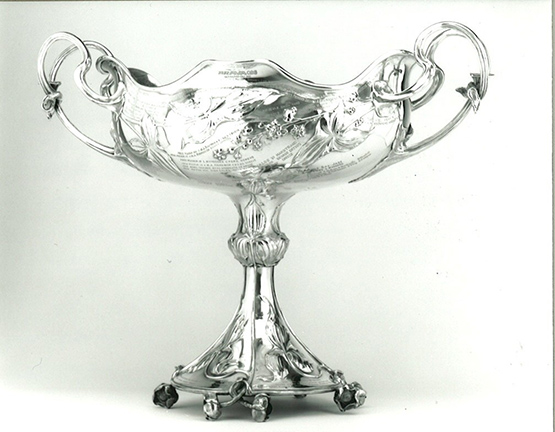 The cause of all the trouble – the One Ton Cup was presented to the CVP by the Earl of Granard, future Commodore of the National YC, in 1898, and was first raced for in 1899.
The cause of all the trouble – the One Ton Cup was presented to the CVP by the Earl of Granard, future Commodore of the National YC, in 1898, and was first raced for in 1899.
The magnificent cup remained as beautiful as ever, but with World War II it became almost forgotten until 1965, when the CVP proposed using it for an inshore-offshore international series for yachts rating at 22ft under the RORC rule, which worked out to be boats around the 36-37ft mark. The idea took off like a rocket - level-rating racing among diverse boats was an idea whose time had come. Very quickly, a whole range of additional international rating levels arose, with Two Tonners around 40-42ft, Three Quarter Tonners around 34ft, Half Tonners around 30ft, Quarter Tonners around 25ft, Mini-Tonners around 21ft, and they even had Micro-Tonners at about 18ft.
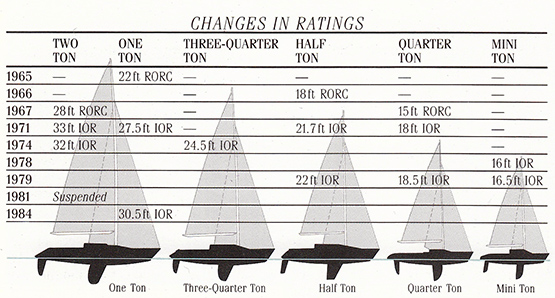 The Ton Classes at their peak
The Ton Classes at their peak
It all worked very well for twenty years and more in some cases (the last Half Tonner was built in 1992), with the boat sizes staying broadly the same size range, but with the ratings changed to accommodate the RORC rule being replaced by the IOR. And Irish sailing certainly had its moments in this continuing circus of various offshore racing acts. In 1974 the Ron Holland-designed, Cork–built 36ft Golden Apple somehow became more famous than the winner by being runner up the One Ton Worlds. But then in 1976, Harold Cudmore and a youthful crew from Cork put all questions aside by managing to get the new race-prepared Ron Holland-designed 30ft Silver Shamrock to Trieste for the Half Ton Worlds, and he won in style, famously celebrating by sailing up the Grand Canal in Venice with spinnaker set.
 The 1976 Half Ton World champion Silver Shamrock, getting an end-of-season lift-out at her current home port of Penzance in Cornwall
The 1976 Half Ton World champion Silver Shamrock, getting an end-of-season lift-out at her current home port of Penzance in Cornwall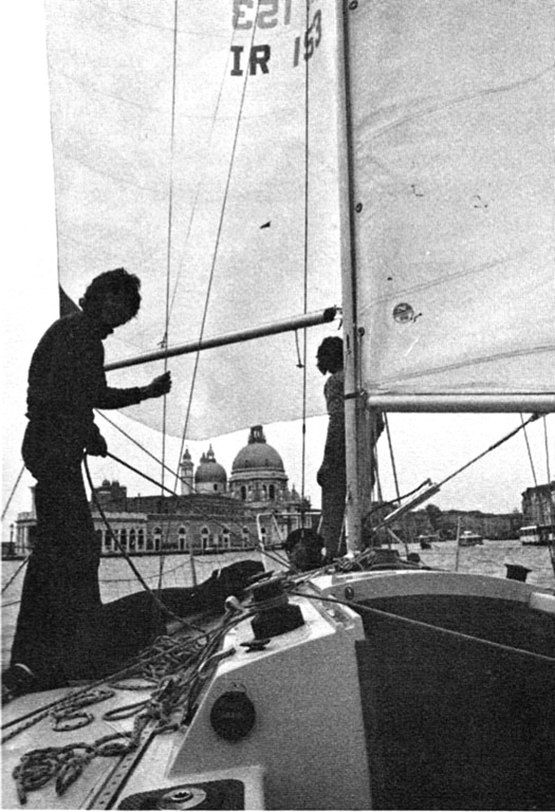 See the conquering heroes come…….Silver Shamrock sailing up the Grand Canal in Venice after winning the Half Ton Worlds 1976 in Trieste under Harold Cudmore’s command. Ronnie Dunphy on left, Killian Bushe on foredeck
See the conquering heroes come…….Silver Shamrock sailing up the Grand Canal in Venice after winning the Half Ton Worlds 1976 in Trieste under Harold Cudmore’s command. Ronnie Dunphy on left, Killian Bushe on foredeck
In 1981 he was back on top again, winning the One Ton Worlds at Crosshaven with the Castro-design Justine IV owned by Frank Woods (NYC). But by this time the boats involved were very different in form from those skinny-sterned designs which had dominated in the earlier 1970s, as a fresh wave of New Zealand designers like Bruce Farr and Laurie Davidson had been showing what could be achieved with broader sterns and better offwind performance.
The Half Ton Worlds was won in 1977, ’78 and ’79 by Kiwi boats of this type. But though she was not the overall winner, Ian Gibbs’ Farr-designed Swuzzlebubble was the one everyone remembered best, as she was on the podium one year as a centreboarder, and back there in the top three the year after, but this time as a keelboat.
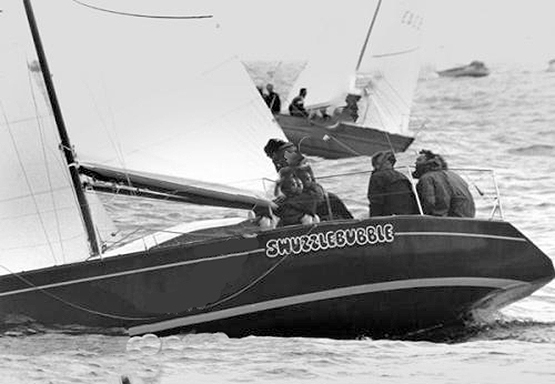 The new wave arrives from New Zealand – Swuzzlebubble in 1979
The new wave arrives from New Zealand – Swuzzlebubble in 1979
The following year she arrived in Ireland in the ownership of Bruce Lyster of Royal St George in Dun Laoghaire, and he won the ISORA Championship in 1980, plus ISORA Week and just about everything for which the boat was eligible in Cowes Week.
He had an exceptional crew of all the talents with Robert Dix, Drewry Pearson and Des Cummins, and Dixie remembers her as one of the most wonderful boats he ever sailed: “She found her own way to peak performance so effortlessly that you’d almost be scared to do anything which might adversely effect the trim” he quips.
He continues to say that even though Bruce Lyster sold Swuzzlebubble to Greece at season’s end, as you simply couldn’t improve on a season like they’d had in 1980. The Three Musketeers meanwhile transferred aboard Ken Rohan’s 40ft Regardless, with which they won their class big time in the 1981 Fastnet.
Regardless would be on most people’s short list for the greatest Irish racing yacht ever, yet Robert Dix remembers the previous season with Swuzzlebubble with even more enthusiasm. So it’s intriguing that at next week’s Henri Lloyd Half Ton Classics Worlds, the new wave of Irish Classic Half Ton sailors will be taking on Swuzzlebubble for the first time.
The story of her re-birth is typical of the modern revival of the very best of the old Ton Cup boats, with the One Ton Championship itself being revived for its Golden Jubilee in New Zealand in 2015 with a classic fleet. As for Swuzzlebubble, she was discovered in a very poor way indeed in a Greek boatyard in 2012, but was brought back to life by the King of Cowes, Peter Morton, who duly won the Half Ton Classics Worlds in Brittany in 2014 with her.
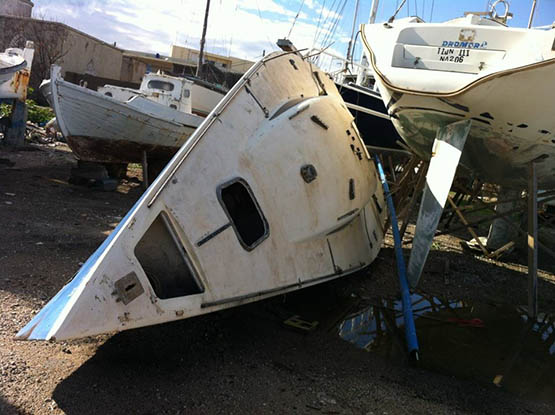 Next stop, the landfill site? Swuzzlebubble as she was found in Greece in 2012
Next stop, the landfill site? Swuzzlebubble as she was found in Greece in 2012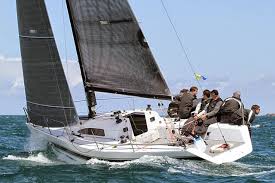 Swuzzlebubble restored, on her way to winning the Half Ton Classics in Brittany in 2014
Swuzzlebubble restored, on her way to winning the Half Ton Classics in Brittany in 2014
However, Swuzzlebubble wasn’t campaigned in the 2015 series in Belgium, when Dave Cullen took the trophy for Ireland with Checkmate XV. So there has been an air of unfinished business about these two rather special boats floating about the ocean without actually locking horns, but that’s all going to be changed in Falmouth.
 Dave Cullen on the helm as Checkmate XV makes a start to die for at the Half Ton Worlds in Belgium, 2015
Dave Cullen on the helm as Checkmate XV makes a start to die for at the Half Ton Worlds in Belgium, 2015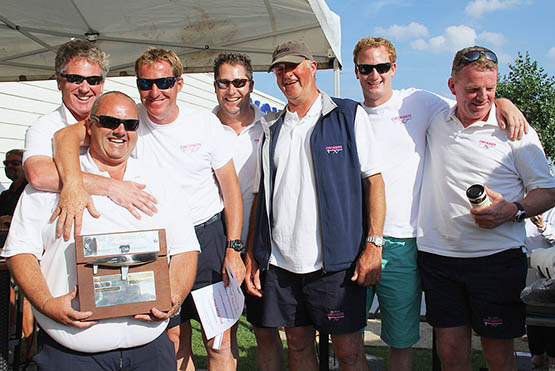 Winners take all – Dave Cullen and his crew with the trophy after victory last year
Winners take all – Dave Cullen and his crew with the trophy after victory last year
In fact, it has become Howth versus Falmouth, as Swuzzlebubble is now Falmouth-owned by Gregory Peck who, in a very varied sailing career, was one of the crew with Dickie Gomes aboard the 83ft catamaran Novanet when a new Round Ireland Record was established in November 1986, but that’s another story altogether.
However, in Falmouth there’ll be other boats involved too, as the word is they might muster as many as 30 entries, which is as big a fleet as anyone could reasonably wish for. The remarkable Howth/Fingal contingent will be there in full strength, as Checkmate XV will be taking the road with Jonny Swann’s Harmony, Michael and Richard Evans’ The Big Picture, and the David Kelly and Patrick Boardman team from Rush SC with King One, Half Ton World Champion in 1981.
It’s an intriguing mixture of nostalgia and modernity, as the boats get revamped to new ideas, yet they always carry their history lightly but definitely with them. In the case of the Howth boats, much of the technical work in revamping is done by ace boatbuilder Alan Power of Malahide, who appropriately is a powerboat nut himself, but his ability to think outside the usual boat-building box makes him the ideal man to undertake crazy notions for addicts of old but still potent offshore racers.
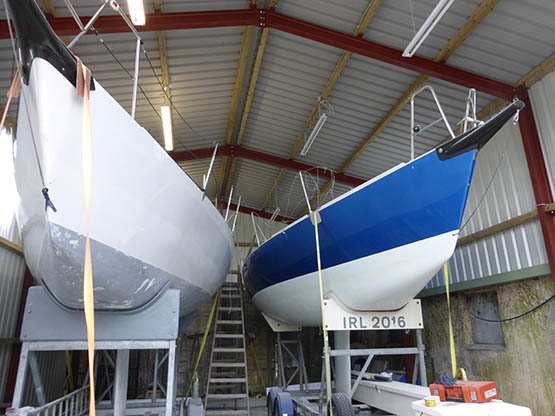
In line with this aim of maximising performance, the Howth/Fingal crewing lineup will include some formidable talent from all over Ireland, with Dave Cullen leading the charge with his 2015 crew of Johnny Murphy, Gary Cullen (no relation), Aidan Beggan, Mark Pettit, James Hynes and Andy George.
The crew on The Big Picture meanwhile have roped in Mark Mansfield of Cork, who is having a great year of it in a variety of boats, while the jockey for King One is young Marty O’Leary, one of the bright new talents to emerge in recent years from Courtown in County Wexford.
Down Falmouth way, it’s going to be Classic Half Ton Racing at its classic best. And if you wonder why it is that the Half Tonners seem to have been the most successful of all the Ton classes in reviving themselves after more than fifty years, perhaps the answer is that at 30ft they’re big enough as boats to be taken seriously, yet small enough to be a manageable proposition for keeping in top order and raced keenly.
 The contemporary Half Ton Classics lineup – the boats are big enough to be taken seriously, yet small enough to be manageable
The contemporary Half Ton Classics lineup – the boats are big enough to be taken seriously, yet small enough to be manageable
Irish Half tonners and Quarter Tonners are shaping up for a full–on season in 2016. Dave Cullen's old Half Tonner King One has reportedly just finished a big refit under new Howth owners which means Cullen's new steed Checkmate, Harmony, Big Picture and now King One are all tricked up and heading for the Half Ton Cup in Falmouth in August.
There is a lot of activity too in Dublin Bay Quarter Ton circles with refits and DBSC boats heading for the Quarter Ton Cup along with Paul Gibbons Anchor Challenge from Cork too.
ICRA Nationals 2014 Will See Duel of Vintage Half–Tonners
#halftonner – In what is being billed as the 'Duel of the Half Tonners' by ICRA organisers for June's National Championships another vintage half–tonner 'The Big Picture' is being optimised for competition. According to ICRA Commodore Norbert Reilly, the Howth campaign plans to take on the Nigel Biggs Sistership MG30, the all conquering ICRA National Champion, Check Mate IV.
Though, currently for sale on Afloat.ie, there is also the prosect of a three way half ton battle with Dave Cullen's King One, a boat that has taken its own share of silverware.
Commodore Reilly's own boat, Crazy Horse is at Malahide marina boatyard to sort out damage sustained at last year's Volvo Dun Laoghaire regatta Week.
The overall leader of the 2013 event was forced out after a collision with J109 clubmate, Storm. Both boats were doing seven knots at the time of the incident.
His Cruisers Zero crew is preparing for the nationals as part of the Howth YC Team and mounting a bid to win the Club Championship Trophy currently held by Royal Irish YC.
Reilly has hinted that former crew mates David Harte and Led Pritchard (both ex Comanche Raider crew) will join the boat.
Irish Half Ton Cup Contender 'King One' Goes Up for Sale
#boatsforsale – King One, the Howth Yacht Club based Half tonner that has competed for Ireland with success at Ramsgate week, the Isle of Wight and the Half ton Cup, is up for sale at €29,950. Skipper Dave Cullen, who won a string of trophies in the 1981 Half Ton Cup winner has updated the Modified Berret hull recent years. Now a 'serious contender' for the Cup again the boat has had over €100k spent recently. Its 2014 IRC handicap is 0.953 and the yacht has a new Mark MIlls keel together with a new carbon Jason Ker rudder and tiller.
The GRP hull was stripped and faired just last season and also in 2013 Seatek racing stanchions and pulpit were fitted.
Please click to view the full King One advert on Afloat boats for sale plus hundreds more yachts, motorboats and dinghies currently for sale.




























